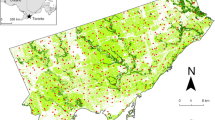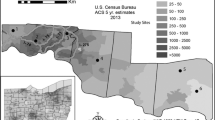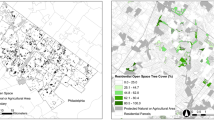Abstract
The changing mode of urban development through time can bring a varied landscape mosaic accompanied by spatial-temporal differentiation of urban vegetation. Hong Kong as an ultra-compact city generates intense interactions between trees and urban fabric to highlight urbanization effects on tree communities. The study areas cover public housing estates which accommodate about half of the 7.26 million population. Thirteen site factors related to estate, landform and habitat traits were measured or computed as surrogate urbanization effects. Species composition and diversity of tree communities in 102 estates were assessed by field surveys, including four estate groups: older or newer ones situated respectively in urban core or new towns. They contain 48,823 trees belonging to 232 species with heavy exotic representation. Total tree density and native tree density in newer estates were significantly higher than older ones. Differences in species richness and diversity and native species richness between older and newer estates were not significant, expressing to a certain extent the floristic-homogenization phenomenon. Multi-response Permutation Procedures (MRPP) results showed significant difference in species composition between older and newer estates, which could be explained by variations in development age, density, town plan and pre-urbanization land cover. Nonmetric Multidimensional Scaling (NMDS) results found tree distribution patterns in four estate groups strongly associated with estate area, open space area, estate population, estate age, Shannon index (H′) at planting strip and tree pit, and tree site quality index. Urban-forest management could be improved by adopting more native species and providing high-quality and spacious planting sites to accommodate more and larger trees. The research methods and findings could be used by policy makers and planners in similar large and developing cities to evaluate, design, maintain and enhance urban biodiversity.




Similar content being viewed by others

References
Allen HD, Randall RE, Amable GS, Devereux BJ (2006) The impact of changing olive cultivation practices on the ground flora of olive groves in the Messara and Psiloritis regions, Crete, Greece. Land Degrad Dev 17:249–273
Angold PG, Sadler JP, Hill MO, Pullin A, Rushton S, Austin K, Small E, Wood B, Wadsworth R, Sanderson R, Thompson K (2006) Biodiversity in urban habitat patches. Sci Total Environ 360:196–204
Bertin RI (2002) Losses of native plant species from Worcester, Massachusetts. Rhodora 104:325–349
Burton E (2002) Measuring urban compactness in UK towns and cities. Environ Plan B: Plan Des 29:219–250
Byers JE (2002) Impact of non-indigenous species on natives enhanced by anthropogenic alteration of selection regimes. Oikos 97:449–458
Byrne LB (2007) Habitat structure: a fundamental concept and framework for urban soil ecology. Urban Ecosys 10:255–274
Census and Statistics Department (2014) Hong Kong annual digest of statistics. Hong Kong SAR Government, Hong Kong
Chapin FS III, Zavaleta ES, Eviner VT, Naylor RL, Vitousek PM, Reynolds HL, Hooper DU, Lavorel S, Sala OE, Hobbie SE, Mack MC, Díaz S (2000) Consequences of changing biodiversity. Nature 405:234–242
Chocholoušková Z, Pyšek P (2003) Changes in composition and structure of urban flora over 120 years: a case study of the city of Plzen. Flora 198:366–376
Colwell RK (2012) EstimateS: Statistical Estimation of Species Richness and Shared Species from Samples. Available from http://viceroy.eeb.uconn.edu/estimates. Accessed Oct 2013
Craul PJ (ed) (1992) Urban soil in landscape design. Wiley, New York
DeCandido R, Muir AA, Gargiullo MB (2004) A first approximation of the historical and extant vascular flora of New York City: implications for native plant species conservation. J Torrey Bot Soc 131:243–251
Dehnen-Schmutz K, Touza J, Perrings C, Williamson M (2007) The horticultural trade and ornamental plant invasions in Britain. Conserv Biol 21:224–231
Duffy JE (2009) Why biodiversity is important to the functioning of real-world ecosystems. Front Ecol Environ 7:437–444
Dwyer JF, McPherson EG, Schroeder HW, Rowntree RA (1992) Assessing the benefits and costs of the urban forest. J Arboric 18:227–234
Fang CF, Ling DL (2005) Guidance for noise reduction provided by tree belts. Landsc Urban Plan 71:29–34
Foley JA, DeFries R, Asner GP, Barford C, Bonan G, Carpenter SR, Chapin FS, Coe MT, Daily GC, Gibbs HK, Helkowski JH, Holloway T, Howard EA, Kucharik CJ, Monfreda C, Patz JA, Prentice IC, Ramankutty N, Snyder PK (2005) Global consequences of land use. Science 309:570–574
Freedman B, Love S, O’Neil B (1996) Tree species composition, structure and carbon storage in stands of urban forest of varying character in Halifax, Nova Scotia. Can Field-Nat 110:675–682
Gaffin SR, Rosenzweig C, Kong AYY (2012) Adapting to climate change through urban green infrastructure. Nat Clim Chang 2:704
Gustafsson L, Appelgren L, Nordin A (2005) Biodiversity value of potential forest fertilisation stands, as assessed by red-listed and ‘signal’ bryophytes and lichens. Silva Fenn 39:191–200
Hong Kong Herbarium (2012) Check List of Hong Kong Plants 2012. Agriculture, Fisheries and Conservation Department, Hong Kong SAR Government, Hong Kong
Hong Kong Observatory (2015) Climate of Hong Kong and Introduction of Climatological Service. Available from http://www.hko.gov.hk/cis/intro_e.htm. Accessed March 2015
Hong Kong Housing Authority (2014) Housing in Figures 2014. Hong Kong SAR Government, Hong Kong
Jim CY (1993) Trees and landscape of a suburban residential neighbourhood in Hong Kong. Landsc Urban Plan 23:119–143
Jim CY (1998) Old stone walls as an ecological habitat for urban trees in Hong Kong. Landsc Urban Plan 42:29–43
Jim CY (2000) The urban forestry programme in the heavily built-up milieu of Hong Kong. Cities 17:271–283
Jim CY (2004) Characteristics of urban park trees in Hong Kong in relation to greenspace planning and development. Acta Horticult 643:123–128
Jim CY (2008) Opportunities and alternatives for enhancing urban forests in compact cities in developing countries. In: Carreiro MM, Song YC, Wu JG (eds) Ecology and management of urban forests: an international perspective. Springer, New York, pp 118–148
Jim CY (2013) Drivers for colonization and sustainable management of tree-dominated stonewall ecosystems. Ecol Eng 57:324–335
Jim CY, Chen WY (2008) Pattern and divergence of tree communities in Taipei’s main urban green spaces. Landsc Urban Plan 84:312–323
Jim CY, Liu HT (2001) Species diversity of three major urban forest types in Guangzhou City, China. For Ecol Manag 14:99–114
Jim CY, Zhang H (2013) Species diversity and spatial differentiation of old-valuable trees in urban Hong Kong. Urban For Urban Green 12:171–182
Jones HP, Hole DG, Zavaleta ES (2012) Harnessing nature to help people adapt to climate change. Nat Clim Chang 2:504–509
Jooss R, Geissler-Strobel S, Trautner J, Hermann G, Kaule G (2009) ‘Conservation responsibilities’ of municipalities for target species: prioritizing conservation by assigning responsibilities to municipalities in Baden-Wuerttemberg, Germany. Landsc Urban Plan 93:218–228
Kareiva P, Watts S, McDonald R, Boucher T (2007) Domesticated nature: shaping landscapes and ecosystems for human welfare. Science 316:1866–1869
Konijnendijk CC (ed) (2008) The forest and the city: the cultural landscape of urban woodland. Springer, Berlin
Konijnendijk CC, Ricard RM, Kenney A, Randrup TB (2006) Defining urban forestry—a comparative perspective of North America and Europe. Urban For Urban Gree 4:93–103
Kowarik I (2011) Novel urban ecosystems, biodiversity, and conservation. Environ Pollut 159:1974–1983
Kunick W (1987) Woody vegetation in settlements. Landsc Urban Plan 14:57–78
Kuo FE, Sullivan WC (2001) Environment and crime in the inner city: Does vegetation reduce crime? Environ Behav 33:343–367
Lam CY (2011) Weather and climate. In: Jim CY, Li SM, Fung T (eds) A new geography of Hong Kong, vol I. Friends of the Country Parks and Cosmos Books, Hong Kong, pp 7–45
Mack RN, Erneberg M (2002) The United States naturalized flora: largely the product of deliberate introductions. Ann Mo Bot Gard 89:176–189
Mack RN, Lonsdale WM (2001) Humans as global plant dispersers: getting more than we bargained for. Bioscience 51:95–102
Magurran AE (ed) (1988) Ecological diversity and its measurement. Princeton University Press, Princeton
Martin CA, Stabler LB (2004) Urban horticultural ecology: interactions between plants, people and the physical environment. Acta Horticult 639:97–102
McCune B, Grace JB (eds) (2002) Analysis of ecological communities. MjM Software Design, Gleneden Beach
McKinney ML (2006) Urbanization as a major cause of biotic homogenization. Biol Conserv 127:247–260
McKinney ML (2008) Effects of urbanization on species richness: a review of plants and animals. Urban Ecosyst 11:161–176
Müller N, Werner P (2010) Urban biodiversity and the case for implementing the convention on biological diversity in towns and cities. In: Müller N, Werner P, Kelcey JG (eds) Urban biodiversity and design. Wiley-Blackwell, Oxford, pp 3–33
Nowak DJ (2002) The effects of urban forests on the physical environment. In: Randrup TB, Konijendijk CC, Christophersen T, Nilsson K (eds) Urban forests and trees. Springer, Amsterdam, pp 22–42
Olden JD, Poff NL, McKinney ML (2006) Forecasting faunal and floral homogenization associated with human population geography in North America. Biol Conserv 127:261–271
Peck JE (ed) (2010) Multivariate analysis for communities ecologists: step-by-step using PC-ORD. MjM Software Design, Gleneden Beach
Peterson G, Allen CR, Holling CS (1998) Ecological resilience, biodiversity, and scale. Ecosystems 1:6–18
Pickett STA, Cadenasso ML, Grove JM, Boone CG, Groffman PM, Irwin E, Kaushal SS, Marshall V, McGrath BP, Nilon CH, Pouyat RV, Szlavecz K, Troy A, Warren P (2011) Urban ecological systems: scientific foundations and a decade of progress. J Environ Manag 92:331–362
Pielou EC (1966) The measurement of diversity in different types of biological collections. J Theor Biol 13:131–44
Planning Department (2014) Planning department annual report. Hong Kong SAR Government, Hong Kong
Pyšek P (1998) Alien and native species in Central European urban floras: a quantitative comparison. J Biogeogr 25:155–163
Reichard SH, White P (2001) Horticulture as pathway of invasive plant introductions in the United States. Bioscience 51:103–113
Ricketts T, Imhoff M (2003) Biodiversity, urban areas, and agriculture: locating priority ecoregions for conservation. Conserv Ecol 8:1–15
Shannon EC, Weaver W (eds) (1963) The mathematical theory of communication. University of Illinois Press, Urbana
Smart A (ed) (2006) The shek Kip Mei myth: squatters, fires and colonial rule in Hong Kong, 1950–1963. Hong Kong Press, Hong Kong
Standley LA (2003) Flora of Needham, Massachusetts: 100 years of floristic change. Rhodora 105:354–378
Sullivan JJ, Timmins SM, Williams PA (2005) Movement of exotic plants into coastal native forests from gardens in northern New Zealand. New Zeal J Ecol 29:1–10
Tait CJ, Daniels CB, Hill RS (2005) Changes in species assemblages within the Adelaide Metropolitan area, Australia, 1836–2002. Ecol Appl 15:346–359
Thompson K, Austin KC, Smith RM, Warren PH, Angold PG, Gaston KJ (2003) Urban domestic gardens (I): putting small-scale plant diversity in context. J Veg Sci 14:71–78
Tratalos J, Fuller RA, Warren PH, Davies RG, Gaston KJ (2007) Urban form, biodiversity potential and ecosystem services. Landsc Urban Plan 83:308–317
Tregear TR, Berry L (eds) (1959) The development of Hong Kong and Kowloon as told in maps. Hong Kong University Press, Hong Kong
Walker JS, Grimm NB, Briggs JM, Gries C, Dugan L (2009) Effects of urbanization on plant species diversity in central Arizona. Front Ecol Environ 7:465–470
Werner P (2007) Urban form and biodiversity. In: Langner M, Endlicher W (eds) Shrinking cities: effects on urban ecology and challenges for urban development. Peter Lang, Frankfurt, pp 57–68
Werner P, Zahner R (2010) Urban patterns and biological diversity: a review. In: Müller N, Werner P, Kelcey JG (eds) Urban biodiversity and design. Wiley-Blackwell, Oxford, pp 145–173
Whitford V, Ennos AR, Handley JF (2001) “City form and natural process”—indicators for the ecological performance of urban areas and their application to Merseyside, UK. Landsc Urban Plan 57:91–103
Wittig R (2004) The origin and development of the urban flora of Central Europe. Urban Ecosyst 7:323–339
Wu J, Jenerette GD, Buyantuyev A, Redman CL (2011) Quantifying spatiotemporal patterns of urbanization: the case of the two fastest growing metropolitan regions in the United States. Ecol Complex 8:1–8
Zaman QMM, Lau SSY, Mei SO (2000) The compact city of Hong Kong: a sustainable module for Asia. In: Jenks M, Burgess R (eds) Compact cities—sustainable urban forms for developing countries. Spon Press, London, pp 255–268
Zerbe S, Maurer U, Schmitz S, Sukopp H (2003) Biodiversity in Berlin and its potential for nature conservation. Landsc Urban Plan 62:139–148
Zhang H, Chu LM (2011) Plant community structure, soil properties and microbial characteristics in revegetated quarries. Ecol Eng 37:1104–1111
Zhang H, Chu LM (2013) Changes in soil seed bank composition during early succession of rehabilitated quarries. Ecol Eng 55:43–50
Zhang H, Jim CY (2013) Species adoption for sustainable forestry in Hong Kong’s degraded countryside. Int J Sust Dev World Ecol 20:484–503
Zhang L, Wang H (2006) Planning an ecological network of Xiamen Island (China) using landscape metrics and network analysis. Landsc Urban Plan 78:449–456
Zhang H, Zhuang XY, Chu LM (2013) Plant recruitment in early development stages on rehabilitated quarries in Hong Kong. Restor Ecol 21:166–173
Zhou D, Fung T, Chu LM (2012) Avian community structure of urban parks in developed and new growth areas: a landscape-scale study in Southeast Asia. Landsc Urban Plan 108:91–102
Zhuang XY, Corlett RT (1997) Forest and forest succession in Hong Kong, China. J Trop Ecol 14:857–866
Zhuang XY, Xing FW, Corlett RT (1997) The tree flora of Hong Kong: distribution and conservation status Memoirs of the Hong Kong Natural History Society 1:69–126
Acknowledgments
We acknowledge with gratitude the research grants kindly awarded by the Hong Kong Housing Authority. Special thanks are due to the Department of Geography, the University of Hong Kong, for access to the digital spatial data purchased from the Hong Kong Government. Thanks are due to postgraduate students of the South China Agricultural University for providing field work assistance.
Author information
Authors and Affiliations
Corresponding author
Rights and permissions
About this article
Cite this article
Jim, C.Y., Zhang, H. Urbanization effects on spatial-temporal differentiation of tree communities in high-density residential areas. Urban Ecosyst 18, 1081–1101 (2015). https://doi.org/10.1007/s11252-015-0455-7
Published:
Issue Date:
DOI: https://doi.org/10.1007/s11252-015-0455-7



